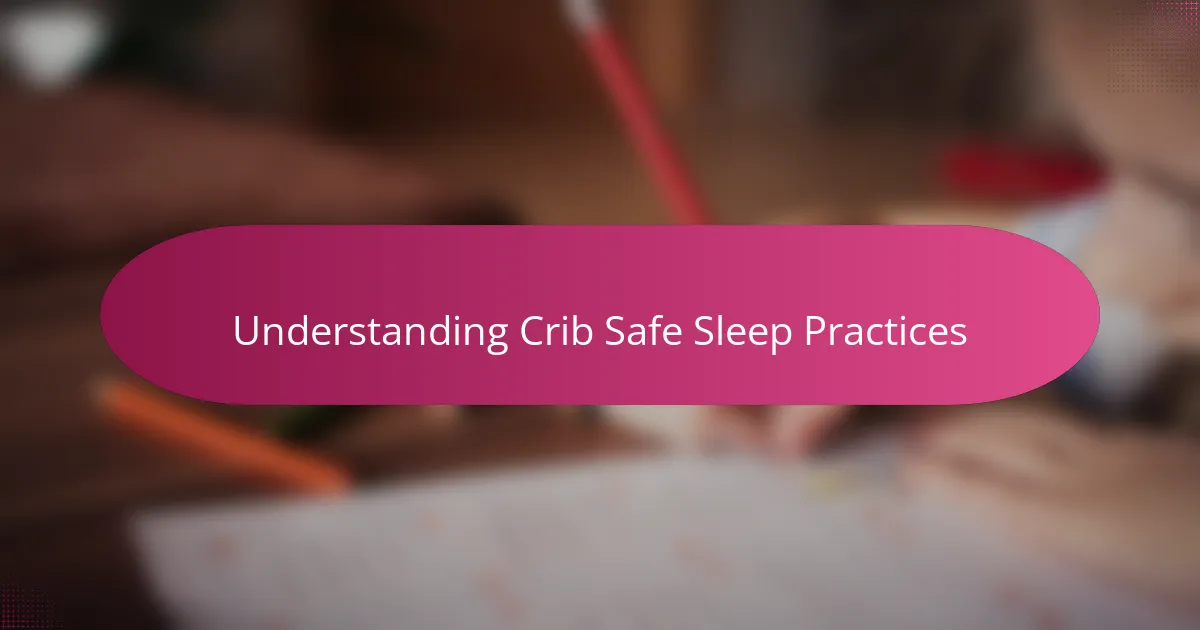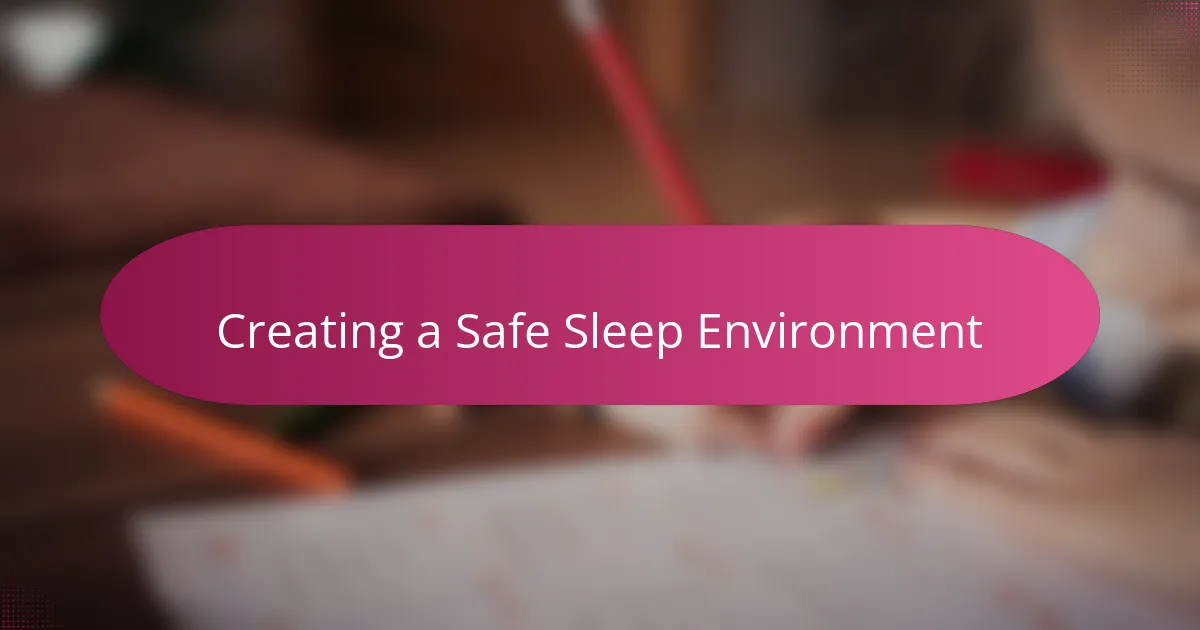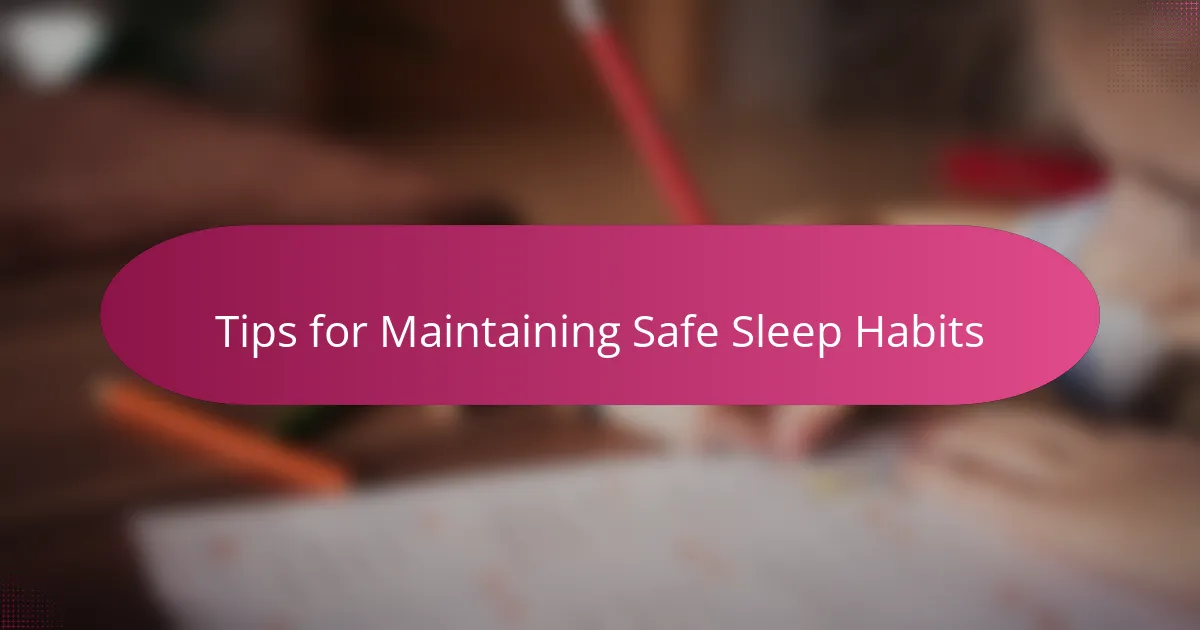Key takeaways
- Always place the baby on their back to sleep and keep the crib bare, using only a firm mattress and fitted sheet to reduce risks of suffocation and SIDS.
- Choose cribs with fixed sides and slats spaced no more than 2 3/8 inches apart, and select a firm, snug-fitting mattress with a waterproof cover.
- Maintain a comfortable room temperature and use dim, indirect lighting to promote a calming sleep environment while ensuring safety.
- Establish a consistent bedtime routine and regularly inspect the crib setup to reinforce safe sleep practices and create a secure space for your baby.

Understanding Crib Safe Sleep Practices
When I first learned about crib safe sleep practices, I was surprised by how much detail there is to consider to ensure a baby’s safety. It made me realize that something as simple as choosing the right mattress or keeping the crib free from loose bedding can make a huge difference in preventing risks like suffocation or SIDS. Have you ever thought about how many everyday items in a nursery might unknowingly pose a danger during sleep?
One thing that really stuck with me is the recommendation to always place the baby on their back to sleep. It sounds straightforward, but understanding why this position is the safest gave me peace of mind during those sleepless nights. I remember worrying if my little one would roll over, but knowing the science behind the advice made me confident in following it consistently.
Another practice that changed how I arranged the nursery was removing everything except a firm mattress and a fitted sheet from the crib. At first, it felt sterile and impersonal, but then I understood that minimizing extras like pillows, bumpers, and toys creates a safer sleep environment. It challenged my instincts to “make the crib cozy” but ultimately put my baby’s safety first.

Key Elements of Modern Nursery Design
When I started designing our nursery, I realized that modern nursery design isn’t just about aesthetics—it’s deeply connected to functionality and safety. Clean lines, neutral tones, and minimalist decor became my go-to choices because they create a calm environment while reducing distractions or clutter that might interfere with safe sleep.
I also found that selecting multi-purpose furniture was a game changer. A sleek crib that adapts as the baby grows or storage solutions that keep essentials organized help maintain a tidy space. Have you noticed how less clutter instantly makes a room feel more peaceful? That feeling mattered to me, especially during those unpredictable nighttime feedings.
Lighting is another subtle but powerful element. Soft, adjustable lights made the nursery inviting without overwhelming the senses. I quickly learned that having control over brightness helped soothe my baby and kept me alert without feeling jolted awake. It’s amazing how something as simple as lighting can influence the whole nursery experience.

Selecting Safe Cribs and Mattresses
Choosing the right crib felt overwhelming at first because safety standards can be so specific. I learned to look for cribs with fixed sides and slats no wider than 2 3/8 inches — this detail gave me confidence that my baby couldn’t get stuck or slip through. Have you ever wondered how something as small as slat spacing could matter so much? Once I knew, it became a priority in my search.
When it came to mattresses, firmness was the game changer for me. I had to remind myself that a firm mattress supports safe sleep and reduces the risk of suffocation. Soft, plush mattresses might seem cozy, but they can actually be dangerous, which I discovered after reading multiple safety guidelines. I ended up choosing one with a waterproof cover too, which made me feel better about unexpected messes.
I also found that buying a mattress that fits snugly in the crib without gaps is essential. It might seem obvious, but floating mattresses or loose fits can pose hazards. I recall measuring the crib frame several times before making a purchase to ensure a perfect fit. That extra care made me feel like I was one step closer to creating a truly safe sleep space.

Creating a Safe Sleep Environment
Creating a safe sleep environment meant rethinking every little detail in the nursery. I was initially tempted to add soft blankets and plush toys to make the crib cozy, but I learned that keeping the space clear of anything extra actually reduces risks. It was tough at first, as I worried the crib looked too bare, but knowing it was safer helped me let go of that feeling.
I also paid close attention to the room’s temperature and airflow. It surprised me how crucial it is to keep the nursery comfortably cool and well-ventilated to prevent overheating—a factor I hadn’t considered before. Setting up a small fan across the room, not directed at the baby, seemed like a simple fix, but it brought me peace of mind every night.
Have you ever thought about how lighting plays into safety? I found that dim, indirect lights not only soothe my baby but also help me check on her without fully waking her up. This subtle adjustment made our nighttime routines smoother and less stressful—for both of us.

Personal Experience with Crib Sleep Setup
Setting up the crib for safe sleep was one of those moments that felt overwhelming yet profoundly important. I remember standing there, measuring the mattress over and over, wanting to be absolutely sure there were no gaps where my baby could get caught. It’s funny how something so simple demanded so much attention, but I realized that precision here translates directly to peace of mind.
I wasn’t prepared for how emotionally challenging it would be to keep the crib so bare—no cozy blankets or stuffed animals, just a firm mattress and a fitted sheet. At first, it felt almost cold, like I was stripping away the warmth I wanted to surround my baby with. But then I reminded myself that this emptiness wasn’t neglect; it was protection, and that changed everything for me.
Did you ever worry about whether your little one might roll into an unsafe position during sleep? I did, especially during those first few nights. But by consistently placing my baby on her back and sticking to the crib setup I carefully designed, I found a rhythm and confidence that helped me sleep a little better too. It’s amazing how these small, thoughtful steps build up to a safer, more restful environment for both of us.

Challenges and Solutions in Nursery Safety
One challenge I faced was balancing safety with comfort. It was hard at first to resist adding soft blankets or plush toys to the crib, but I kept reminding myself that these items increase risks like suffocation. Have you ever struggled to prioritize safety over coziness? For me, understanding the stakes helped me stay firm in creating a bare but secure sleep space.
Another hurdle was organizing the nursery to minimize clutter while still keeping everything I needed close at hand. I found that clever storage and multi-purpose furniture made a big difference. When the room stayed tidy and airy, I felt less anxious about hidden hazards and more confident in the nursery’s safety.
I also had to stay vigilant about maintaining safe sleep practices even during tired, late-night moments. It’s easy to become lax when exhaustion hits, but I made a habit of double-checking the crib setup every time. Those small, mindful routines gave me peace of mind and reinforced that safety isn’t a one-time task—it’s an ongoing commitment.

Tips for Maintaining Safe Sleep Habits
One tip that really stuck with me was establishing a consistent bedtime routine. I found that calming activities like gentle rocking or soft lullabies signaled to my baby that it was time to sleep, which helped ease the transition and reduced fussiness. Have you noticed how a predictable routine can make nights less chaotic? For me, it was a game changer.
Another habit I learned to keep up with was regularly inspecting the crib’s setup. I’ll admit, sometimes I got tired and tempted to overlook small things, but those quick checks made me feel more secure. Making it a simple part of my nightly routine—the same way I brush my teeth—helped me stay committed without feeling overwhelmed.
Lastly, I became very intentional about dressing my baby appropriately for the room temperature. Instead of piling on blankets, I opted for breathable sleepwear that kept my baby comfortable without risking overheating. It was a small adjustment but knowing that I was preventing heat-related risks gave me a lot of comfort during those overnight hours.
